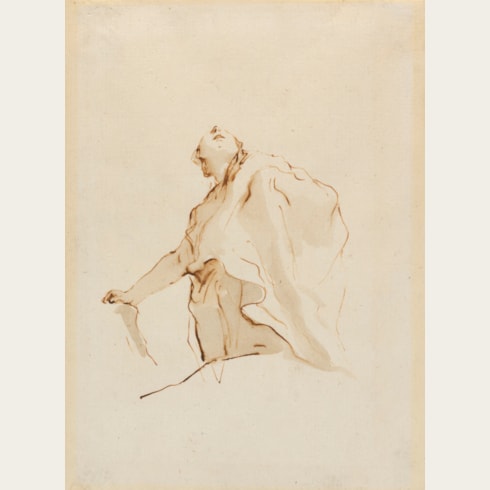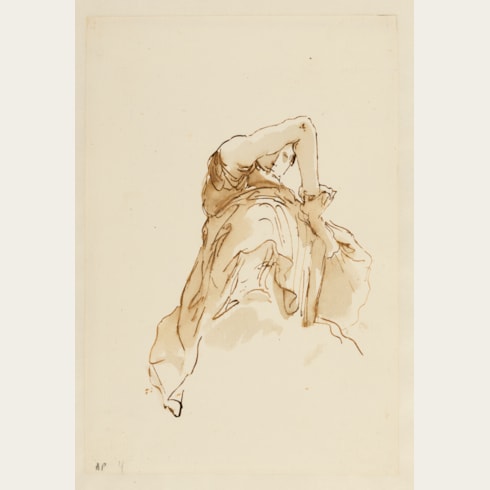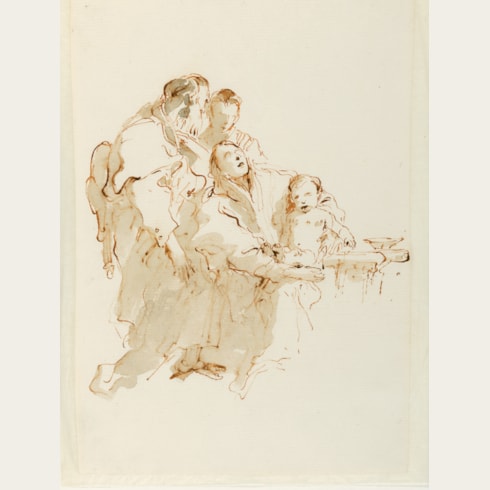Giovanni Battista TIEPOLO
(Venice 1696 - Madrid 1770)
Landscape with a View over Rooftops
Inscribed (in a modern hand) D. Tiepolo a Lombardy Town on the old backing board.
152 x 274 mm. (6 x 10 3/4 in.) [sheet]
As the early 20th century English writer William Bateson – who was also an avid collector of Tiepolo drawings - has described these landscape drawings by Giambattista, ‘They are accurate sketches from nature of buildings, mostly villas and farms in full sunlight, evidently made for the purpose of acquiring facility in handling strong lights and shadows, in which the master attained such extraordinary skill. All were obviously done with extreme rapidity...Some of the outlines may have been made with the pen, but most are brush work. The surfaces in shadow are given with simple washes, the depth of shade being indicated almost always by the tone of the wash alone without hatching. In this power of precise modulation of tint without either exaggeration or monotony, Tiepolo stands perhaps alone with Rembrandt, of whom this group of drawings in curiously reminiscent. But whereas Rembrandt’s farms are always represented in co-ordinated space as incidents in complete compositions, the Tiepolo sketches are merely detached studies. Though such farm buildings are a familiar feature in Venetian pictures from early times, it does not appear that Tiepolo ever introduced them into his finished works.’
Devoid of any human presence, Giambattista Tiepolo’s landscape drawings in pen and wash are evocative of the heat and shadows of an Italian summer. In these drawings, as Michael Levey has written, ‘Each shape is firmly reduced to essentials, moulded by the light and baked by the heat, so that from them there seems to exude a smell of dry straw and tile and earth, like the perennial scent of the Italian countryside in summer.’ The artist does not appear to have ever used these drawings in his painted work, and they seem instead to have been done as a record of the unfamiliar countryside and towns beyond his native Venice. Many of the drawings, including the present sheet, show rooftops and chimneys, and must have been made from upstairs windows.
A comparable drawing of a city view by Giambattista Tiepolo, formerly part of the Franz Koenigs collection, is today in the Pushkin Museum in Moscow, while a similar study of A View from Tiepolo’s House in Venice, with the Church of San Felice – the artist’s only known drawing of his native city – is in the Museum Boijmans van Beuningen in Rotterdam. A close stylistic comparison may also be made with a drawing of Rooftops in a City in the Albertina in Vienna and a View of a Town in the Veneto with a Tower (Monselice) in the Krugier-Poniatowski collection in Geneva.
It seems likely that among the albums of drawings kept in the Tiepolo studio was a book of landscape sketches in pen and ink wash, and that this was one of several albums of Tiepolo drawings acquired, around the middle of the 19th century, by the English collector Edward Cheney. The Cheney albums were in turn acquired, after his death, by the London dealer Parsons and Sons, and their contents dispersed over the next two or three decades. Thirty-five of the landscape drawings, including the present sheet, were bought, probably from Parsons, by the artist Alphonse Legros, and eventually sold at two auctions in 1918. Others were acquired, also probably from Parsons, by the artists and designers Charles Ricketts and Charles Shannon, and later bequeathed to the Fitzwilliam Museum in Cambridge.
A small but significant group of eight landscape drawings by Giambattista Tiepolo is now in the Fitzwilliam Museum, while another set of five landscapes is in the Museum Boijmans van Beuningen in Rotterdam. Other landscape drawings by the artist are today in the collections of the Kupferstichkabinett in Berlin, the Fogg Art Museum in Cambridge, Massachusetts, the British Museum and the Courtauld Gallery in London, the J. Paul Getty Museum in Los Angeles, the Metropolitan Museum of Art and the Pierpont Morgan Library in New York, the Fondation Custodia in Paris, and elsewhere.
Domenico Tiepolo often copied and adapted his father’s drawings in his own finished drawings of the 1790s, and the present sheet was used by the younger artist, over thirty years later, for the landscape background of his drawing of A Turkish Lancer and Onlookers Approaching a Town in the the Metropolitan Museum of Art in New York; one of a series of finished drawings known as the ‘Scenes of Contemporary Life’ of c.1791.
The leading painter in Venice for much of his career, Giambattista Tiepolo was also undoubtedly one of the finest Italian draughtsmen of the 18th century. That his drawings were greatly admired in his lifetime is confirmed by contemporary accounts; indeed, as early as 1732 the writer Vincenzo da Canal remarked that ‘engravers and copyists are eager to copy his works, to glean his inventions and extraordinary ideas; his drawings are already so highly esteemed that books of them are sent to the most distant countries’. From the late 1730’s until his departure for Spain in 1762, Tiepolo enjoyed his most productive period as a draughtsman, creating a large number of vibrant pen and wash studies that are among the archetypal drawings of the Venetian Settecento. As one recent scholar has commented, ‘From the start of his career [Tiepolo] had enjoyed drawing as an additional means of expression, with equally original results. He did not draw simply to make an immediate note of his ideas, nor to make an initial sketch for a painting or to study details; he drew to give the freest, most complete expression to his genius. His drawings can be considered as an autonomous artistic genre; they constitute an enormous part of his work, giving expression to a quite extraordinary excursion of the imagination; in this respect, Tiepolo’s graphic work can be compared only with that of Rembrandt.’
Tiepolo’s drawings include compositional studies for paintings and prints, drawings of heads, figure studies for large-scale decorations, landscapes and caricatures, as well as several series of drawings on such themes as the Holy Family. Many of these drawings were bound into albums by theme or subject, and retained by the artist in his studio as a stock of motifs and ideas for use in his own work, or that of his sons and assistants.
Provenance
Literature


























